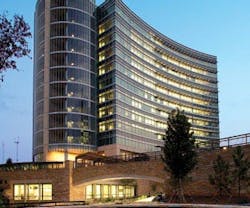Imagine a LEED point that gives you the power to minimize your impact on wildlife and human health while putting money back into your pocket.
The Light Pollution Reduction point – SS Credit 8 – provides guidelines for reducing interior and exterior lighting levels. These adjustments, in turn, provide ongoing energy savings.
Brighter lighting is ultimately poor lighting. The credit’s intent is to:
-
Minimize light trespass from the building and site.
-
Reduce skyglow to increase night sky access.
-
Improve nighttime visibility through glare reduction.
-
Reduce development impact from lighting on nocturnal environments.
Follow the Rules of Good Lighting
To curtail these forms of over-illumination and meet the credit’s specifications, adhere to the principles of proper lighting. According to Richard Heinisch, manager of energy and environmental standards with Acuity Brands Lighting, lighting design boils down to one simple principle – put the right amount of light in the right place at the right time. SS Credit 8 offers a detailed breakdown of footcandles across four project zones, as well as specific times lights should be adjusted.
Though every building pollutes with light, the SS Credit 8 is often bypassed because documentation requires professional assistance, explains Heinisch. Unlike points that can be earned by simply selecting the right product, like a bike rack, SS Credit 8 involves careful planning and the involvement of a lighting designer.
"This is also a calculation-intensive credit," says Heinisch. "The point demands the technical wherewithal to calculate horizontal and vertical illuminances at a variety of locations, along with an assessment of luminaire photometrics to determine compliance with sky glow requirements."
Whether you pursue LEED certification or build to its standards, there are several simple lighting tips that you can follow:
-
A properly placed luminaire minimizes errant light.
-
Take advantage of lighting controls to reduce or extinguish light levels.
-
Use shielded luminaires whenever possible.
-
High-efficacy fixtures support desired lighting levels using lower watts.
-
Directional lighting – lighting from above – is the most effective use of lighting.
"Ultimately, the challenge is not to get the credit, but to educate owners as to what good lighting is," says Micah Rosen, associate principal with TVS Design, an architectural firm.
CDC Gets Tough on Light Trespass
Located in Atlanta, the Centers for Disease Control and Prevention (CDC) earned LEED Silver in 2006 for the Arlen Specter Headquarters and Operations Center. The building’s glass envelope and large amount of green space presented lighting concerns that prompted TVS Design to evaluate SS Credit 8.
Because CDC is a 24-hour operation, security lighting is a top priority. The building is located on 10 acres of green space with frequently used sidewalks. However, the preliminary light fixtures not only leaked light into the sky, but also flooded light well beyond the sidewalk’s edges. "We were able to find an alternative from the same manufacturer’s line of products that was downlight only and fully shielded," says Rosen.
The design team also found it could use pedestrian poles intermittently with the addition of bollards, which use localized light better suited to the 5-foot sidewalks. "Because bollards can be spaced closely together, you can use a lower footcandle level and get a more even spread of light," says Rosen. Both changes – the downlight-only pedestrian poles and the bollards – were made within the budget.
To reduce spill light from the building’s glass envelope, a series of solar shades and interior reflectors was installed, as well as two tints of low-E glass. Green-tinted glass reduces glare and provides shade for occupants. At the 7-foot level, the shades reflect natural light through clear glass. This strategy eliminated the need for artificial light within 8 feet of the building’s perimeter. "This reduction in artificial light allows us to minimize light trespass at night," says Rosen.
Like many others, TVS Design didn’t initially flag the light pollution reduction point as a must-do. Instead, it found that by following good lighting designs, it naturally met the credit’s goals.
Jennie Morton ([email protected]) is assistant editor of BUILDINGS.
About the Author
Jennie Morton
A former BUILDINGS editor, Jennie Morton is a freelance writer specializing in commercial architecture, IoT and proptech.
